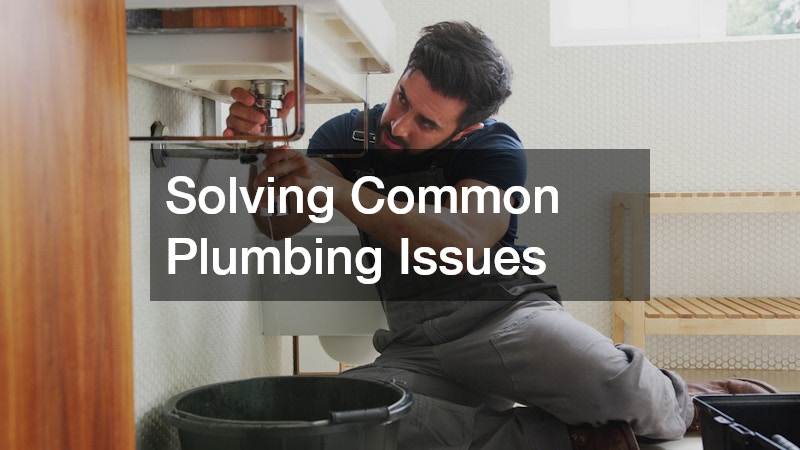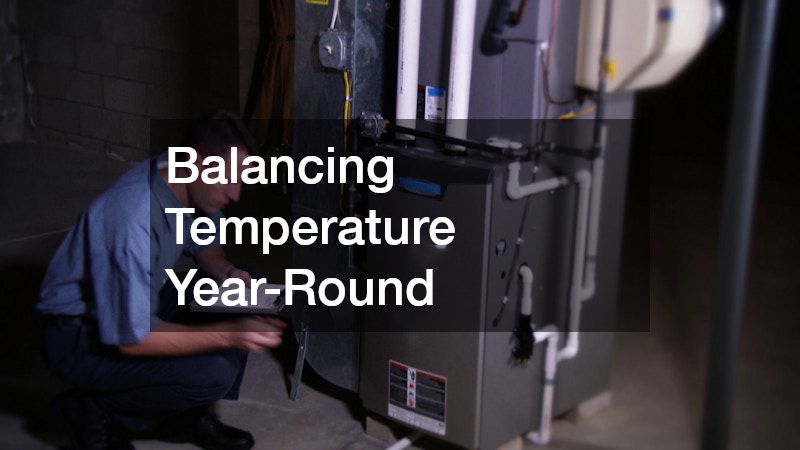Learning to handle home repairs can be both empowering and cost-effective. For new homeowners or those simply wanting to become more self-sufficient, gaining a solid foundation in home maintenance is crucial. While some repairs require expert intervention, many tasks can be learned with patience and attention to detail. From roof leaks to garage door installation, understanding how your home systems function will save time and money and boost your confidence as a homeowner.
Throughout this guide, we’ll cover a range of home repair areas—from structural fixes to utility upkeep. We’ll also highlight when it’s wise to call in help and how professional installations can ensure long-term efficiency and safety. Whether you’re facing a sudden plumbing issue or want to replace an outdated AC unit, this beginner’s guide will set you on the right path. Let’s explore the essential areas of home repairs and how you can start mastering them today.
Assessing Roofing Damage and Necessary Fixes
One of the most important parts of your home is the roof, as it protects everything beneath it. As a beginner, you may not feel comfortable climbing onto your roof, but you can still perform visual inspections from the ground or through attic access. Look for missing shingles, sagging areas, or water stains on your ceilings—signs that you might need roof repair services. Even a minor leak can escalate quickly into a major problem, so timely action is essential.
You might be tempted to patch things up with sealant or shingles from your local store. While this may offer a temporary solution, more extensive damage often requires the touch of trained professionals. That’s when professional installations come into play. A roofing contractor can ensure the job is done correctly, using the appropriate materials and securing everything to weatherproof standards.
If your roof is older than 15 years or has been through several storms, it may be time for a full inspection. It’s always better to be proactive rather than wait for a leak to reveal itself through interior damage. Don’t delay repairs, and make regular checks part of your annual home maintenance.
Keeping Your Cool with AC Troubleshooting

When summer hits, few things are more vital than a functioning air conditioner. If your cooling system fails, you’re likely facing discomfort and increased energy bills. A common issue homeowners encounter is a malfunctioning or weak system that doesn’t cool the house evenly. This is when air conditioning repairs are crucial.
Some repairs can be DIY, such as replacing a filter or cleaning condenser coils. However, when you experience refrigerant leaks, electrical faults, or unusual noises, it’s best to call in HVAC professionals. You’ll want the job handled with care, which is where professional installations and repair services make a huge difference. These experts not only fix the current issue but also ensure the system is efficient for future use.
Preventive maintenance is key. Schedule an annual tune-up in early spring to avoid being stuck during peak heat. By catching problems early, you reduce the risk of major breakdowns. If your unit is older or failing frequently, it might be more cost-effective to replace it altogether. We’ll cover that next in more detail when we explore installing a new AC system.
Starting Fresh with a New AC Unit
If your air conditioner is outdated, inefficient, or breaks down repeatedly, it might be time to invest in ac installation. Modern air conditioning systems are more energy-efficient and offer better cooling performance, which can help lower utility bills and increase comfort. Knowing what to expect during the installation process is helpful for beginners, especially when working with contractors.
Typically, your HVAC technician will assess your home’s size and insulation to determine the proper system capacity. Choosing an energy-efficient unit with a SEER rating that meets your climate’s needs is essential. Poor installation can lead to frequent malfunctions, which is why professional installations are a must for HVAC systems.
Improperly installed units may fail to cool effectively or may use more power than necessary. A skilled installer ensures proper ductwork connection, refrigerant levels, and thermostat calibration. With a new AC unit in place, your home will not only feel better, but it will run more efficiently. Be sure to keep your documentation, as warranties and regular maintenance are critical for longevity.
Solving Common Plumbing Issues

Plumbing problems are among the most common home repair challenges. Whether it’s a leaky faucet, clogged drain, or backed-up toilet, a quick response can prevent water damage and mold growth. For more complex jobs like pipe replacement or drain line inspection, it’s advisable to work with a reputable plumbing company.
Beginner-friendly plumbing fixes include replacing worn washers, plunging blockages, and using drain snakes for minor clogs. However, when leaks are behind walls or under flooring, it’s a job for professionals. Hiring a licensed plumber ensures adherence to codes and avoids future problems due to improper installation or repair.
Professional installations of water heaters, toilets, or sinks offer peace of mind and reduce the chance of flooding or structural water damage. Plumbing is one of those systems where a minor mistake can become a major expense quickly. Building a relationship with a local plumbing company can also mean faster emergency service when issues strike suddenly.
As you grow more confident with simple plumbing tasks, you can gradually take on bigger projects. Just know your limits and don’t hesitate to bring in the pros when the stakes are high.
Maintaining Your Pressure Tank
If your home uses well water, it likely relies on a water pressure tank. This component stores water and regulates pressure, ensuring that you receive a consistent flow from your taps and appliances. Over time, tanks can lose pressure or develop leaks, leading to sputtering faucets and noisy pipes.
A faulty tank might also cause your well pump to cycle on and off more frequently than necessary, which can significantly reduce the lifespan of the system. As a beginner, you can check the tank’s pressure with a standard air gauge and compare it to your switch setting. If the pressure is too low, you may need to add air or replace the tank’s bladder.
Although some adjustments can be made yourself, professional installations are highly recommended when replacing the tank or diagnosing persistent issues. A technician can ensure the system is properly balanced and that water pressure meets your home’s needs. Maintenance tasks like draining sediment and inspecting valves can also extend the life of your tank.
Regularly checking the pressure tank and understanding how it works will help you identify problems before they become urgent. It’s one more step toward mastering your home’s inner workings.
Upgrading Garage Access
Whether you’re dealing with an aging system or building a new home, a garage door install is a significant upgrade that combines security, convenience, and curb appeal. Modern garage doors come in various styles and materials, from insulated steel to custom wood finishes. Choosing the right type is only the beginning—the installation process is where things can get tricky.
Installing a garage door involves heavy lifting, precise alignment, and electrical wiring for the opener. Even if you’re handy, the risk of injury from torsion springs makes DIY installation dangerous. This is one project where professional installations aren’t just preferable—they’re essential.
Once installed, regular maintenance is fairly simple. Lubricate the tracks, tighten hardware, and test the sensors every few months. If your door is slow, noisy, or doesn’t open evenly, these are signs that something’s wrong. Keep the manual handy, and know when to call a pro.
Your garage door system is one of the most-used entry points in your home. Investing in a quality installation and learning basic upkeep will ensure it continues operating safely and smoothly for years to come.
Balancing Temperature Year-Round

Your home’s heating and cooling system is vital for comfort during both the hottest summer days and coldest winter nights. These systems are often complex, combining furnaces, heat pumps, air conditioners, and ductwork. Understanding the basics helps homeowners know what to look for when problems arise or upgrades are needed.
Common issues include poor airflow, uneven room temperatures, and inconsistent operation. While filter changes and thermostat adjustments are simple fixes, more serious problems may require replacing components or reworking duct layouts. For such tasks, professional installations are not only helpful—they’re essential for safety and performance.
Modern systems are more energy-efficient and come with smart features for zone control and scheduling. Upgrading your system can drastically reduce energy consumption, but only when installed and configured correctly. Maintenance also plays a key role in extending the lifespan of the system.
It’s beneficial to schedule seasonal inspections—before summer and winter—to check refrigerant levels, test ignition systems, and inspect duct integrity. With a well-maintained heating and cooling setup, your home will remain comfortable regardless of the season.
Protecting Your Home with Durable Roofing
When it comes time to replace your roof, one increasingly popular option is metal roofing. Unlike traditional asphalt shingles, metal roofs offer impressive durability, energy efficiency, and longevity. They can last 40 to 70 years with proper maintenance, making them a great long-term investment.
Metal roofs reflect heat, which can reduce cooling costs in the summer. They’re also fire-resistant and withstand harsh weather better than many other materials. While some homeowners worry about noise during rainstorms, newer installations include underlayments that significantly reduce sound. Because of their weight and structure, however, installation must be done precisely.
That’s where professional installations shine. An improperly installed metal roof can lead to leaks, rust, or structural failure. Professionals will ensure all seams are sealed, panels are correctly anchored, and ventilation is adequate.
Metal roofing also comes in a variety of finishes and colors, so you don’t have to sacrifice style for function. Whether you’re replacing an old roof or building from scratch, this material is worth considering for its resilience and efficiency.
Handling Pavement Cracks and Damage

Driveway wear and tear is something every homeowner will eventually face. From minor cracks to crumbling edges, the best way to extend the life of your pavement is with regular maintenance and occasional help from asphalt repair services. Asphalt is durable, but it’s not invincible—especially in areas with fluctuating temperatures or heavy vehicles.
You can fill small cracks yourself with patching compounds or sealants, but larger issues like potholes or drainage problems call for a professional. Routine sealing every few years will help protect the surface and prevent moisture from infiltrating and freezing beneath.
Hiring professional installation or repair experts ensures proper grading and compaction, especially if you’re laying down a new driveway or expanding an existing one. A poorly installed surface may not drain correctly, leading to early deterioration and costly repairs.
Keeping your driveway clean, avoiding harsh chemicals, and addressing damage early are key to long-lasting pavement. Like every other part of your home, attention and care go a long way toward avoiding major fixes.
Responding to Moisture and Flooding Issues
Water damage is one of the most destructive and expensive home issues. Whether it comes from a storm, burst pipe, or faulty appliance, acting quickly can minimize harm. Water repair services are critical when large areas are soaked or mold is starting to grow.
Initial steps include stopping the source of water, drying out affected areas, and removing damaged materials. While you can start the cleanup process yourself with towels and fans, full-scale restoration often requires specialized equipment and know-how. That’s where professional installations and restoration teams come into play.
These services use moisture meters, industrial dehumidifiers, and antimicrobial treatments to ensure thorough drying and prevent mold. Depending on the extent of the damage, flooring, drywall, and even framing may need to be replaced.
To prevent future issues, inspect your home’s drainage system, gutters, and foundation regularly. Installing a sump pump or backflow preventer can add another layer of protection. Water damage can be overwhelming, but with the right response, your home can be restored to its original condition or better.
Mastering home repairs takes time, patience, and a willingness to learn. As you gain experience, you’ll begin to recognize what’s within your capability and when to seek help. Simple tasks like patching holes or replacing light fixtures are great places to start, while more advanced work—like HVAC systems or plumbing—often calls for professional installations to ensure safety and reliability.
Building a toolkit, watching tutorials, and keeping up with seasonal maintenance will make you a proactive, confident homeowner. Remember, homeownership isn’t just about enjoying your space—it’s about protecting and improving it continuously.
In all things, prioritize quality and safety. Whether you’re working with contractors or tackling a project yourself, the goal is to create a space that’s comfortable, functional, and built to last.
